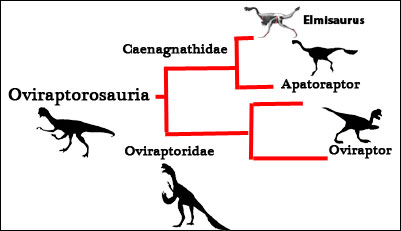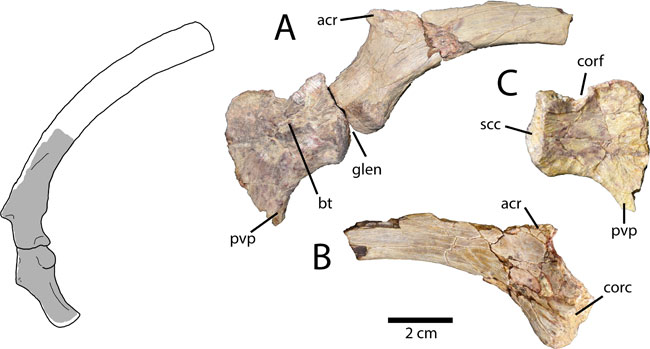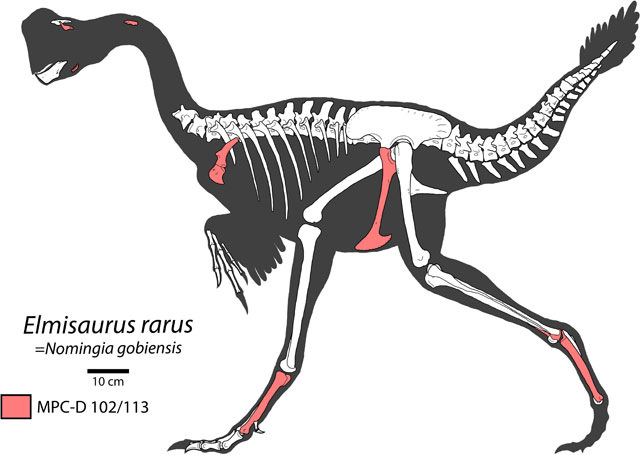The clade of very bird-like dinosaurs known as the Oviraptorosauria, were very successful and widely distributed in the Northern Hemisphere during the Late Cretaceous. For example, the Nemegt Formation (Mongolia), is famous for the numerous oviraptorosaur dinosaurs that have been named and described from fossils, dinosaurs such as Conchoraptor, Rinchenia, Gobiraptor and the recently described two-fingered Oksoko (O. avarsan) that we featured in an article in October 2020: A New Species of Two-fingered Oviraptorosaur is Described.

Analysis of fragmentary fossil remains attributed to the caenagnathid Elmisaurus suggests that these members of the oviraptorosaur clade (the Caenagnathidae) were actually rare in Mongolia compared to the much more numerous and diverse oviraptorids.
Researchers, which include the eminent Professor Phil Currie (University of Alberta), writing in PLOS One conclude that caenagnathids may have been outcompeted by other oviraptorosaurs and as such, caenagnathids like Elmisaurus only made up a tiny portion of the dinosaur population associated with the Nemegt Formation.
Examining the Oviraptorosauria
The Oviraptorosauria clade consists primarily of two large families of feathered dinosaur, the Caenagnathidae “recent jaws” and the closely related Oviraptoridae “egg thieves”.
Overall, the anatomy of caenagnathids is very similar to that of oviraptorids, but there are a number of differences. For example, caenagnathid jaws exhibited a distinct suite of specialisations not seen in other oviraptorosaurs. The jaws of caenagnathids tend to be relatively long and shallow, this suggests that their bite was not as powerful. The inside of the lower jaws also reveal a complex series of ridges and tooth-like processes, as well as a pair of horizontal, shelf-like ridges. Recent studies have demonstrated that as caenagnathids grew and got older they started to lose their teeth (ontogenetic edentulism).
The unusual jawbone morphology was produced by various tooth reduction patterns and this in turn, suggests that these dinosaurs changed their diet as they matured. Furthermore, the jaws of caenagnathids are unusual as the bones are hollow and air filled. In addition, in general terms caenagnathids tend to be more lightly built than the closely related oviraptorids.

Picture credit: Everything Dinosaur
Nomingia gobiensis Actually Elmisaurus rarus
Two members of the Caenagnathidae had been described from fossils associated with the Nemegt Formation, Elmisaurus rarus which was scientifically described back in 1981 and Nomingia gobiensis which was named in the year 2000. The research team which included Gregory Funston (University of Edinburgh), Chinzorig Tsogtbaatar (North Carolina State University), Tsogtbaatar Khishigjav (Mongolian Academy of Sciences) as well as Professor Currie, examined a partial skeleton which had been discovered in 2018, close to the site where the holotype fossils of Nomingia had been found.
The team were able to highlight similarities in the overlapping elements of Elmisaurus and Nomingia. They concluded that fossil material previously attributed to Nomingia gobiensis might represent Elmisaurus rarus and that just one species of caenagnathid is known from the Nemegt Formation.

Oviraptorids Outcompeted Caenagnathids
The researchers discount the idea that a bias in fieldwork has led to the lack of caenagnathid fossil specimens found. After all, numerous small dinosaurs such as dromaeosaurids and oviraptorids are known from Nemegt Formation. The team postulated that the caenagnathids were marginalised and out competed by the similarly sized oviraptorids.

Differences in Asian and North American Late Cretaceous Ecosystems
The lack of caenagnathids reported from the Nemegt Formation might reflect competition amongst different types of small, cursorial, feathered dinosaurs. In North America, caenagnathids were the only oviraptorosaurs present (no oviraptorids are currently known from North America). In contrast, both oviraptorids and another type of oviraptorosaur closely related to the Caenagnathidae – the avimimids Avimimus portentosus and Avimimus nemegtensis were present in Mongolia during the Late Cretaceous.
The researchers conclude that although the highly diverse Nemegt Formation oviraptorids probably had very specialised diets, they may have outcompeted the caenagnathids in the niche of small omnivores.

As Nomingia gobiensis was named and scientifically described some nineteen years after Elmisaurus rarus, the research team postulate that Nomingia gobiensis should be regarded as a junior synonym of Elmisaurus. In addition, low caenagnathid diversity in the Nemegt Formation might reflect their inability to compete with other oviraptorosaurs, particularly oviraptorids.
The scientific paper: “A partial oviraptorosaur skeleton suggests low caenagnathid diversity in the Late Cretaceous Nemegt Formation of Mongolia” by Gregory F. Funston, Philip J. Currie, Chinzorig Tsogtbaatar, Tsogtbaatar Khishigjav published in PLOS One.
The Everything Dinosaur website: Dinosaur Figures, Models and Toys.






Leave A Comment